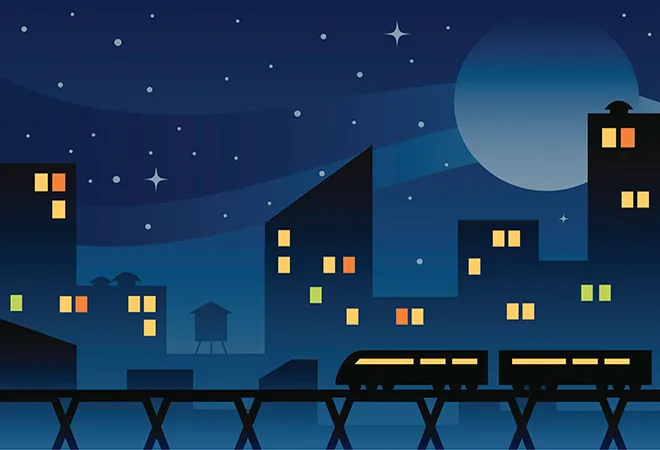-
CENTRES
Progammes & Centres
Location
As India gradually opens up after the lockdown, the gains from the MV Act seem to be unravelling as we seem to be going back to our old normal of congested cities and a high road fatality rate.

The COVID-19 pandemic induced lockdown has reportedly saved nearly 20,000 people from dying in road accidents. Between April and June 2020, road fatalities claimed 20,732 lives compared to 41,032 lives during the same time last year, as per the quarterly data provided by the States and Union Territories to the Supreme Court committee on road safety.
In the year 2019 alone, road fatalities claimed 1,49,068 lives in India and caused injuries to 4,52,242 persons. As of 1 September 2020, the deadly corona virus has claimed 65,288 lives in India, and counting. The pandemic has shone light on the severely neglected aspects of healthcare delivery and has forced the Indian government to take steps to fill the gaping holes in our healthcare system.
The amendment to the Motor Vehicle Act, which came into effect from 1 September 2019, was aimed at enhancing road safety measures and reducing the huge number of road fatalities in India. However, as India gradually opens up after the lockdown, the gains from the MV Act seem to be unravelling as we seem to be going back to our old normal of congested cities and a high road fatality rate. As metropolitan, inter-city and inter-state transport and traffic resumes without restrictions, there can be several reasons for the rise in road accidents and fatalities even as our fight against COVID-19 continues. It is important to acknowledge this and bring back the focus to the key point of the MV Act — to ensure road safety for all. Let us look at some issues that need to be addressed urgently:
Through Unlock 3.0, the central government has stated that all COVID-19-related restrictions on inter-state movement of people and goods will be lifted for travel to non-containment zones. Restrictions have further eased through the new Unlock 4.0 guidelines issued by the Centre and various state governments. The Indian corporate sector has also come up with an action plan of phase-wise resumption of activities. However regular travel on long-distance, local and even metro trains in some cities remains suspended till further notice. Hence, for the majority of population who relies on public transport instead, non-availability of trains spells huge difficulties in getting to their workplace or ensuring ease of travel.
Due to this, the entire onus of public transport provision in Indian cities and metros falls on the city bus transport agencies. With an already ageing fleet, and no support from regular train or metro services, the city buses alone are woefully inadequate to ensure travelling keeping in line the social distancing measures. Studies in cities of Delhi, Pune, Nagpur and Mumbai have pointed out to this fact, some pointing out that we need to have 24 times more buses than are currently plying on our city roads. Inadequate numbers of buses throw social distancing norms out the window and increase the risk of transmission.
All these reasons could have impacted citizens’ commuting behaviours and there seems to be a distinct preference for personal mobility over public transport, given the fear of transmission and inadequacy of public transport in cities. Both new and used car and two-wheeler sales have picked up since May 2020.
The Ministry of Housing and Urban Affairs (MoHUA) has issued guidelines for state governments to focus on non-motorised transport (NMT) options like bicycling and pedestrianisation as a response to COVID-19 induced challenges to urban mobility. However, the focus on NMT combined with inadequate public transport and increase in private vehicles signals an increased risk to road safety.
The smart cities mission recently launched the Cycles4Change challenge aimed to promote cycling culture in Indian cities as a response to COVID-19 pandemic and to enable a green economic recovery for cities. Several cities are already working on bicycle plans and on promoting bicycling culture through non-profits like the cycle mayor system.
With cities trying to welcome cyclists and pedestrians back on their roads, there needs to be a similar emphasis to change motorists’ mindset to welcome NMT users on the road. Bike lanes and foot paths need to be planned, laid out and strictly followed keeping in mind that the majority of road users in this country do not own a car. While there is has been no recent study undertaken to analyse motorist’s attitudes towards cyclists in India, previous studies and media reports have shown that cyclists are generally seen in an unfavourable light by other road users. At other times, cyclists remain in the blind spot of bigger vehicles like trucks, increasing the chance of collisions and injuries.
It is true that Indian cities have an inadequate number of bike lanes and overall poor bike and pedestrian infrastructure. However, merely installing separators between NMT and motorised part of the road will not ensure safety. There is a definite need to overhaul our driving culture — of all motorised transport — beginning with motorised two wheelers including motorcycles, scooters, and now e-scooters and other vehicles. Elsewhere, in highly motorised countries, the primary cause for road accidents involving cyclists is often motorists’ attitudes towards them. As India looks to promote NMT as a way to a green recovery from COVID-19, it needs to promote a more friendly road culture towards its NMT users.
According to a ‘Driving Cities Index’ survey conducted in over 100 cities, Mumbai and Kolkata come at the bottom of the list with some of the worst road rage-related incidences. During 2010-2013, road accidents were the biggest killer amongst males between 15-29 years across the country. In 2015, 54 percent of road accident deaths were in the age group of 15-34. Road accidents are often responsible for loss of income and source of livelihood, economic difficulties and huge medical bills for the survivors of these accidents.
While the MV Act 2019 provides financial relief to road accident victims through insurance, it does not protect from the psychological damages that road rage in India inflicts on travellers. Typical road rage behaviours in India include honking, lane cutting, deliberately damaging other’s vehicles, over taking and over speeding from the wrong lane, verbal and sometimes even physical abuse. The driving tests in India conducted by regional transport offices in various places, do not sensitise against such road rage behaviours that claim more lives in a year than a deadly virus.
Though an increased focus on NMT is a welcome move, measures like driver training, road safety awareness need to be carried out, at the Union, federal and local levels to increase motorists’ acceptance of cycles and pedestrians. In turn, cyclists and pedestrians also need to follow road safety norms. Helmets, protective gear, head and tail lamps for cyclists in dark conditions and anti- jaywalking rules for pedestrians need to be established. NMT needs to be brought under road safety rules and norms need to be established for cyclists and pedestrians, and strengthened for motorists, keeping in mind the unique road conditions on Indian roads.
The views expressed above belong to the author(s). ORF research and analyses now available on Telegram! Click here to access our curated content — blogs, longforms and interviews.

Amruta Ponkshe was Associate Fellow with the Sustainable Development Programme at ORF. Amruta works on mobility and urban infrastructure issues with a special focus on ...
Read More +